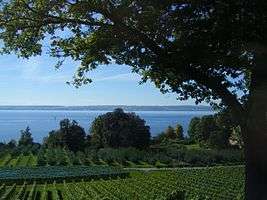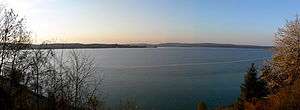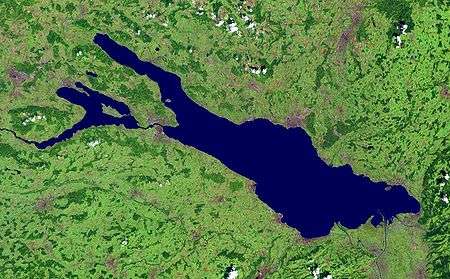Lake Constance
| Lake Constance Bodensee | |
|---|---|
|
satellite image | |
|
map | |
| Location | Germany, Switzerland, Austria |
| Coordinates | 47°35′N 9°28′E / 47.583°N 9.467°ECoordinates: 47°35′N 9°28′E / 47.583°N 9.467°E |
| Primary inflows | Rhine |
| Primary outflows | Rhine |
| Catchment area | 11,500 km2 (4,400 sq mi) |
| Basin countries | Germany, Switzerland, Austria |
| Max. length | 63 km (39 mi) |
| Max. width | 14 km (8.7 mi) |
| Surface area | 571 km2 (220 sq mi) |
| Average depth | 90 m (300 ft) |
| Max. depth | 251 m (823 ft) |
| Water volume | 51.4 km3 (12 cu mi) |
| Residence time | 4.3 years |
| Surface elevation | 395 m (1,296 ft) |
| Frozen | 1795, 1830, 1880 (partial), 1963 |
| Islands | Mainau, Reichenau, Lindau |
| Sections/sub-basins | Obersee, Überlinger See; Untersee, Zeller See, Gnadensee |
| Settlements | see list |
Lake Constance (German: Bodensee) is a lake on the Rhine at the northern foot of the Alps, and consists of three bodies of water: the Obersee ("upper lake"), the Untersee ("lower lake"), and a connecting stretch of the Rhine, called the Seerhein.
The lake is situated in Germany, Switzerland and Austria near the Alps. Its shorelines lie in the German states of Bavaria and Baden-Württemberg, the Austrian state of Vorarlberg, and the Swiss cantons of Thurgau, St Gallen and Schaffhausen. The river Rhine flows into the lake from the south, with its original course forming the Austro-Swiss border, and has its outflow of the "Lower Lake" where - except for Schaffhausen - it forms the German-Swiss border until the city Basel.
Description
Freshwater Lake Constance is central Europe's third largest, after Lake Balaton and Lake Geneva. It is 63 km (39 mi) long, and at its widest point, nearly 14 km (8.7 mi). It covers approximately 571 km2 (220 sq mi),[1] and is 395 m (1,296 ft) above sea level. The greatest depth is 252 metres (827 ft) in the middle of the eastern part (Obersee). Its volume is approximately 10×109 m3 (13×109 cu yd). The lake has four parts: the main section, called Obersee, 476 km2 (184 sq mi); the north section, Überlinger See, 61 km2 (24 sq mi); the west section, Untersee, 63 km2 (24 sq mi); and the northwest section, the Zeller See and Gnadensee. The regulated Rhine flows into the lake in the southeast, through the Obersee, the city of Konstanz and the Untersee, and flows out near Stein am Rhein. The lake itself is an important drinking water source for southwestern Germany, called Bodensee-Wasserversorgung ("Lake Constance Water Supply"). The culminating point of the lake's drainage basin is the Tödi at 3,614 metres above sea level.[2]
Car ferries link Romanshorn to Friedrichshafen, and Konstanz to Meersburg.
History
Lake Constance was formed by the Rhine Glacier during the ice age and is a zungenbecken lake. The Rhine, the Bregenzer Ache, and the Dornbirner Ache carry sediments from the Alps to the lake, thus gradually decreasing the depth and coastline extension of the lake in the southeast.
Lake Constance was first mentioned by the Roman geographer Pomponius Mela about 43 AD. He noted that the Rhine flows through two lakes, and gave them the Latin names Lacus Venetus (Obersee) and Lacus Acronius (Untersee). Pliny the Elder used the name Lacus Brigantinus, after the Roman city of Brigantium (today Bregenz). The lake is also colloquially known as the Swabian Sea[3] (das schwäbische Meer).
The lake was frozen in the years 1077 (?), 1326 (partial), 1378 (partial), 1435, 1465 (partial), 1477 (partial), 1491 (partial?), 1517 (partial), 1571 (partial), 1573, 1600 (partial), 1684, 1695, 1709 (partial), 1795, 1830, 1880 (partial), and 1963.
Approximately 1,000 tonnes (1,100 short tons) of fish were caught by 150 professional fishermen in 2001 which was below the previous ten year average of 1,200 tonnes (1,300 short tons) per year. The Lake Constance trout (Salmo trutta) was almost extinct in the 1980s due to pollution, but thanks to protective measures they have made a significant return. Lake Constance is the home of the critically endangered species of trout Salvelinus profundus,[4] and formerly also the now extinct Lake Constance whitefish (Coregonus gutturosus).[5]
Name

After the Council of Constance, the Latin-speaking Catholic world gave the lake its current international name. It was derived from the city of Konstanz, that, in turn, was named after a Roman emperor (either Constantius Chlorus or his grandson Constantius II). The German name, Bodensee, derives from the town of Bodman, situated at a nearby branch of the lake some 8 km northwest of Konstanz.
International borders
Lake Constance is the only area in Europe where no borders exist, because there is no legally binding agreement as to where the borders lie between Switzerland, Germany and Austria.[6] However, Switzerland holds the view that the border runs through the middle of the lake, Austria is of the opinion that the contentious area belongs to all the states on its banks, which is known as a "condominium", and Germany holds an ambiguous opinion.[7] Legal questions pertaining to ship transport and fishing are regulated in separate treaties.
Naturally, disputes arise. One concerns a houseboat which was moored in two states (ECJ c. 224/97 Erich Ciola); another concerns the rights to fish in the Bay of Bregenz. In relation to the latter, an Austrian family was of the opinion that it alone had the right to fish in broad portions of the bay. However, this was accepted neither by the Austrian courts nor by the organs and courts of the other states.[8]
Recent floods
- A 100-year flood around June 1999 (Pfingsthochwasser 1999) raised the level about 2 metres above normal, flooding harbors and many shoreline buildings and hotels.
- In late August 2005, heavy rain raised the level by more than 70 cm in a few days. The rains caused widespread flooding and washed out highways and railroads.

Tourism, leisure and sports
The tourism and leisure industry is an important factor for this region. Overnight stays reached 17,56m visitors in 2012 with an turnover of about 1.9bn Euros. The same amount comes from the 70 million daily visitors that visit Lake Constance each year.[9]

This region is known for sightseeing, water-sports, winter-sports like Skiing, summer-sports like Swimming (sport), Sailing and recreation. It is also one of the few places where modern Zeppelin airships operate and 12-14 people can take a trip above the lake around various points of interests. [10]
The lake and the region around it have a substantial touristic infrastructure as well as many attractions and points of interests. Important are especially cities like Konstanz, Überlingen, Meersburg, Friedrichshafen, Lindau and Bregenz as they are the big hubs for boating tourism. The main tourism attractions are places like Rhine Falls, one of the three biggest waterfalls in Europe, the Mainau Island and Reichenau Island (UNESCO world heritage), the pilgrimage church Birnau, castles and palaces like Salem Abbey, Meersburg Castle as well as another UNESCO world heritage site, the Pfahlbaumuseum Unteruhldingen (German for 'Stilt house museum).
In the east of the lake, the Alps are reaching almost to it thus allowing a great view over the lake. The Pfänderbahn goes from top of the mountain right down, next to the lake in Bregenz.
Biking around the lake is also possible on the 261 km long trail called "Bodensee-Radweg". It brings its visitors to the most interesting sites and goes around the whole lake. Nevertheless, various shortcuts via ferries allow shorter routes and the trail is suitable for all levels.[11] Note: There is also a trail that goes by the name "Bodensee-Rundweg".[12] This road was intended for pedestrians so biking is sometimes not suitable or allowed.
Furthermore, Lake Constance is the location for the annual Bregenzer Festspiele, a well known arts festival that also takes place on a floating stage in Bregenz. Opera and music performances generally tend to come from popular pieces and among contributors are top music bands like the Vienna Symphony Orchestra.
Islands in the lake
The three major islands are:
These are all of the islands and former islands in Lake Constance, listed from east to west:
| Island | Area (m²) | Population | Municipality | Country | Coordinates | |
|---|---|---|---|---|---|---|
| 1 | Galgeninsel | peninsula since 19th century | - | Lindau (Reutin district) | Germany | |
| 2 | Hoy | 53 | - | Lindau (Reutin district) | Germany | |
| 3 | Lindau | 680,000 | 3,000 | Lindau (Island district) | Germany | |
| 4 | Wasserburg | peninsula since 1720 | 27 | Wasserburg (Island district) | Germany | |
| 5 | Mainau | 447,584 | 185 | Konstanz (Litzelstetten district) | Germany | |
| 6 | Dominikanerinsel | 18,318 | 21 | Konstanz (Altstadt district) | Germany | |
| 7 | Mittlerer Langbohl | 31,254 | - | Konstanz (Industriegebiet district) | Germany | |
| 8 | Triboldingerbohl | 135,570 | - | Konstanz (Industriegebiet district) | Germany | |
| 9 | Reichenau | 4,300,000 | 3.200 | Reichenau (Niederzell|Mittelzell|Oberzell) | Germany | 47°41′40″N 09°03′48″E / 47.69444°N 9.06333°E |
| 10 | Liebesinsel | 300 | - | Radolfzell (Mettnau district) | Germany | |
| 11 | Werd | 15,854 | 9 | Eschenz (Untereschenz district) | Switzerland | |
| 12 | Mittleres Werdli | 4,000 | - | Stein am Rhein | Switzerland | |
| 13 | Unteres Werdli | 6,000 | - | Stein am Rhein | Switzerland | |
| Lake Constance Islands | 5,637,079 | 6,400 | 6 municipalities |
Towns and cities at the lake




Austria
Germany
From the entry of the Rhine, on the northern or right shore:
- On the Upper Lake (Obersee) and Überlinger See
- Konstanz with suburbs
- Wallhausen
- Dingelsdorf
- Litzelstetten
- On the lower lake (Untersee)
- Reichenau (including the island with same name)
- Allensbach (on Gnadensee)
- Radolfzell (on Zellersee)
- Moos
- Gaienhofen
- Öhningen
Switzerland
From the entry of the Rhine, on the southern or left shore:
- On the Upper Lake (Obersee)
- Altenrhein, St. Gallen
- Rorschach, St. Gallen
- Horn, Thurgau
- Steinach, St. Gallen
- Arbon, Thurgau (as all the following)
- Frasnacht
- Egnach
- Romanshorn
- Uttwil
- Kesswil
- Güttingen
- Altnau
- Landschlacht
- Münsterlingen
- Bottighofen
- Kreuzlingen (and Konstanz, Germany)
- On the Rhine
- On the Lower Lake (Untersee)
See also
- Überlingen mid-air collision
- Württembergischer Yacht Club
- Lake Constance is also the title of a track from Mike Oldfield's The Millennium Bell album
- Obersee (Lake Constance)
References
Notes
- ↑ Image #432, Flying Camera Satellite Images 1999, Lloyd Reeds Map Collection, McMaster University Library.
- ↑ 1:25,000 topographic map (Map). Swisstopo. Retrieved 2014-07-27.
- ↑ McLachlan, Gordon (2004) The Rough Guide to Germany. London: Rough Guides Ltd. ISBN 1-84353-293-X.
- ↑ ‘Extinct’ fish found in Lake Constance
- ↑ Red List - Volume 1: Vertebrates (2009) - General assessment for the vertebrate groups
- ↑ Kahn, Daniel-Erasmus (2004). Die deutschen Staatsgrenzen: rechtshistorische Grundlagen und offene Rechtsfragen ("The German national borders: legal-historical foundations and open legal questions"). Oxford University Press. ISBN 9783161484032.
- ↑ Jennings, Ken (June 16, 2014) "The Borderless Black Hole in the Middle of Europe" Conde Nast Traveler
- ↑ Mark, David and Smith, Barry, et al., "Bizarre Shapes: 100 Geographic Monsters"
- ↑ "DWIF - dwif Wirtschaftsfaktor Tourismus Bodenseeregion". Retrieved 2017-01-02.
- ↑ "Zeppelinflug : Bodensee Tourismus". www.bodensee.eu. Retrieved 2017-01-02.
- ↑ "Bodensee-Radweg". Bodensee-Radweg (in German). Retrieved 2017-01-02.
- ↑ "Wandern rund um den Bodensee". www.fernwege.de. Retrieved 2016-12-30.
Further reading
- Zimmermann, Rolf (2004) A Look at Lake Constance. Konstanz: Stadler Verlagsgesellschaft. ISBN 3-7977-0507-7. (Pictures and texts of the cities around Lake Constance).
External links
| Wikimedia Commons has media related to Lake Constance. |
| Wikivoyage has a travel guide for Lake Constance. |
- Bodensee-Hochwasser (in German) waterlevels
- Internationale Bodenseekonferenz
- Regio Bodensee Statistics
- Lake Constance: pictures
- Photos of Lake Constance
- Bibliography on Water Resources and International Law Peace Palace Library
- GrenzRaumSee: A project from the Ludwig-Uhland-Institut für Empirische Kulturwissenschaft (Ludwig-Uhland-Department of European Ethnology / Empirical Cultural Science) of the University of Tübingen
- Lake Constance/Bodensee Lessons learned managing the lake
- Lake Constance Accommodation
- Tourist Information Lake Constance
- Karl Heinz Burmeister: Lake Constance in German, French and Italian in the online Historical Dictionary of Switzerland.
- Nixdorf, B.; et al. (2004), "Bodensee" (PDF), Dokumentation von Zustand und Entwicklung der wichtigsten Seen Deutschlands (in German), Berlin: Umweltbundesamt, p. 4


